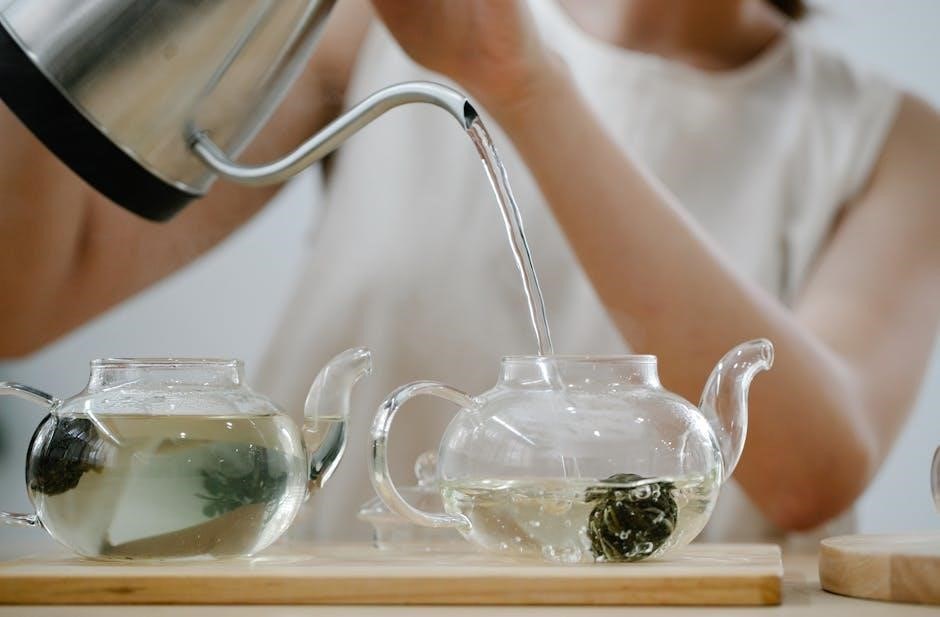Mouthpiece boiling instructions guide you through fitting and shaping your boil-and-bite mouthguard for optimal protection and comfort. This process involves heating the mouthpiece to mold it to your teeth and gums, ensuring a secure fit. Proper boiling and fitting are crucial for effective protection during sports or dental treatments.
Overview of Mouthpiece Boiling
Mouthpiece boiling is a common method for fitting boil-and-bite mouthguards, ensuring a secure and comfortable fit. The process involves submerging the mouthpiece in boiling water to soften the material, allowing it to mold to your teeth and gums. After boiling, the mouthpiece is bitten into to create an impression of your dental structure. This step is crucial for achieving maximum protection and comfort. Proper boiling and cooling times are essential to avoid overheating or under-shaping the mouthpiece. The process typically requires a pot of boiling water, a bowl of cold water, and a towel for handling. Once molded, the mouthpiece should fit snugly, providing effective protection during sports or dental treatments. This method is widely used for its simplicity and effectiveness.
Importance of Proper Boiling and Fitting
Proper boiling and fitting of a mouthpiece are essential for ensuring comfort, protection, and longevity. Incorrect boiling can lead to a poorly shaped mouthguard, offering inadequate protection and causing discomfort. Overheating may cause the material to become too soft, leading to a loose fit, while underheating can result in a rigid mouthpiece that doesn’t mold properly. A well-fitted mouthguard stays securely in place, reducing the risk of dental injuries during sports or dental procedures. Proper fitting also prevents irritation and ensures the mouthpiece doesn’t impede breathing or speech. By following the correct boiling and fitting steps, you achieve a custom-like fit at home, enhancing both performance and safety.

Preparation for Boiling
Gather materials: a saucepan, water, a utensil to handle the mouthpiece, a bowl for cold water, and a towel. Ensure all items are ready before starting. Keep scissors nearby for trimming. Safety first—never let children handle boiling water unattended. Proper preparation ensures a smooth and safe boiling process.
Materials Needed
To successfully boil and fit your mouthpiece, you will need a few essential items. Start with a saucepan of water and a heat source to bring it to a boil. A utensil like a fork or tongs is necessary for safely handling the mouthpiece. You’ll also need a bowl of cold water for cooling and a clean towel to dry the mouthpiece. Scissors may be required for trimming excess material, and a timer is helpful to ensure the correct boiling duration. Lastly, have the mouthpiece itself ready. Gathering all these materials beforehand ensures a smooth and efficient process. Proper preparation is key to achieving the best results.
Choosing the Right Mouthpiece
Selecting the right mouthpiece is crucial for both comfort and protection. Opt for a boil-and-bite mouthguard, as it is specifically designed to be molded to your teeth. These mouthpieces are made from thermoplastic material that softens when heated, allowing for a custom fit. Consider the thickness of the mouthpiece, as thicker options provide greater protection for high-impact sports. Ensure the mouthpiece covers all necessary areas, including your upper teeth and gums. While custom-made mouthguards from a dentist offer the best fit, boil-and-bite options are a cost-effective and accessible alternative. Proper fit is essential to avoid discomfort or irritation during use. Always follow the manufacturer’s guidelines and take your time during the fitting process to achieve the best results. A well-fitted mouthpiece ensures maximum protection and comfort.
Understanding the Boiling Process
Understanding the boiling process is key to achieving a proper fit for your mouthpiece. Begin by bringing water to a rolling boil in a saucepan or kettle. Once boiling, reduce the heat slightly and carefully submerge the mouthpiece into the water using a fork or tongs. Allow it to soften for 30 seconds to 1 minute—exceeding this time may cause excessive shrinking. After boiling, remove the mouthpiece with a utensil and briefly cool it under running water or in a bowl of cold water for a few seconds. This step ensures the mouthpiece is pliable but not too hot to handle. Properly boiling and cooling ensures the material is moldable, allowing for an accurate impression of your teeth and gums.

The Boiling Process
Boil water to a rolling boil, submerge the mouthpiece for 30-60 seconds, then remove and cool slightly before shaping. Timing is crucial to avoid overheating or shrinking.
Heating the Water
To begin the boiling process, fill a saucepan with enough water to fully submerge the mouthpiece. Place the saucepan on a stove and set the heat to medium-high until the water reaches a rolling boil. Once boiling, reduce the heat slightly to maintain a steady simmer. Avoid overheating, as excessive heat can damage the mouthpiece material. Let the water stand for about 30 seconds after boiling to ensure it’s hot but not scalding. This step is crucial for softening the mouthpiece material, making it moldable for a proper fit. Always use caution when handling boiling water to prevent burns or accidents.
Submerging the Mouthpiece

Once the water is boiling, carefully place the mouthpiece into the water using a fork or spoon to ensure it is fully submerged. Allow the mouthpiece to sit in the boiling water for 30 to 60 seconds, depending on the manufacturer’s instructions. Do not exceed the recommended time, as overexposure can cause the material to become too soft or misshapen. Use the utensil to gently hold the mouthpiece underwater, ensuring even heating. Avoid letting it sink to the bottom, as this could cause uneven softening. After the recommended time, remove the mouthpiece from the water with the utensil, taking care to handle it safely. Proper submersion is essential for achieving the right consistency for molding.
Timing the Boil
Timing is critical when boiling your mouthpiece. Most manufacturers recommend submerging the mouthpiece in boiling water for 30 to 60 seconds. Use a timer to ensure accuracy, as overheating can cause the material to become too soft or misshapen. Once submerged, monitor the time closely to avoid exceeding the recommended duration. After the timer goes off, promptly remove the mouthpiece from the water using a fork or spoon to prevent it from staying in too long. Proper timing ensures the material is pliable but not overly softened, allowing for an optimal fit during the molding process. Avoid leaving it in for longer than necessary, as this can compromise the mouthpiece’s structural integrity.
Removing and Cooling the Mouthpiece
Once the boiling time is complete, carefully remove the mouthpiece from the water using a fork or spoon to avoid burns. Gently shake off excess water and let it cool for 5-10 seconds. It should still feel warm but not scalding. Immediately place the mouthpiece into your mouth, aligning it with your upper teeth. Bite down firmly and suck in gently to mold it to your teeth and gums. Hold this position for 20-30 seconds to ensure proper shaping. Remove it and let it cool completely before trimming any excess material. Proper cooling ensures the mouthpiece retains its shape and provides a snug, comfortable fit.

Fitting the Mouthpiece
Fitting involves biting down to mold the mouthpiece to your teeth and gums. Press edges firmly with fingers for a snug fit, ensuring maximum protection and comfort.
Biting Down and Shaping
Biting down firmly on the mouthpiece after boiling is essential for shaping. Once removed from boiling water, quickly place the mouthpiece in your mouth and bite down hard. Use your fingers to press the edges of the mouthpiece against your teeth and gums, ensuring a snug fit. Hold this position for about 30 seconds to allow the material to mold to your mouth’s shape. This step ensures maximum protection and comfort, adapting the mouthpiece to your unique dental structure for optimal performance during sports or dental treatments. Proper alignment and pressure are key for achieving the desired fit.
Adjusting the Fit
After boiling and biting down, adjustments may be necessary for optimal comfort and protection. If the mouthpiece feels too bulky or uncomfortable, carefully trim excess material using scissors or a sharp knife. Ensure the edges are smooth to avoid irritation. Pay special attention to the areas around the molars and gum line, as these are common points of discomfort. Once trimmed, reboil the mouthpiece if needed and repeat the biting process to refine the fit further. Proper adjustments ensure the mouthpiece stays securely in place, providing both comfort and effective protection during use. Regular checks and minor tweaks can help maintain the ideal fit over time.
Checking for Proper Alignment
After fitting the mouthpiece, it’s essential to check for proper alignment to ensure maximum protection and comfort. The mouthpiece should align evenly with your upper teeth, covering them completely without extending too far. Check that it doesn’t press uncomfortably against the lower teeth or gums, as this can cause discomfort or shifting during use. Ensure the mouthpiece stays in place without excessive movement and doesn’t impede your ability to speak or breathe. If misalignment occurs, reboil the mouthpiece and adjust the fit by biting down gently. Proper alignment ensures the mouthpiece provides optimal protection for your teeth and mouth during sports or dental procedures.
Trimming Excess Material
After fitting the mouthpiece, excess material may need to be trimmed for comfort and proper fit. Use sharp scissors or clippers to carefully trim the edges, ensuring the mouthpiece doesn’t extend beyond your second molars. Avoid cutting too much at once, as this can compromise protection. Trim in small increments, checking the fit periodically. If the mouthpiece feels bulky or irritates the back of your mouth, trimming can help. Be cautious not to remove too much material, as this may reduce the mouthpiece’s protective coverage. After trimming, rinse the mouthpiece with cold water and inspect it for any rough edges. Proper trimming ensures a comfortable, secure fit and optimal protection for your teeth and mouth.

Caring for the Mouthpiece
Regular cleaning, proper drying, and secure storage are essential for maintaining hygiene and prolonging the life of your mouthpiece.
Cleaning the Mouthpiece
Cleaning your mouthpiece regularly is essential for hygiene and longevity. Use mild soap and warm water to gently scrub away plaque and bacteria. Avoid harsh chemicals or abrasive materials that could damage the surface. For tougher stains, a soft toothbrush and toothpaste can be effective. Rinse thoroughly with clean water to remove any residue. Some users also soak the mouthpiece in mouthwash for added sanitization. After cleaning, ensure the mouthpiece is completely dry before storing it in a ventilated container to prevent bacterial growth. Regular cleaning helps maintain comfort and ensures the mouthpiece remains effective in protecting your teeth and gums.
Drying and Storing
Proper drying and storage are crucial for maintaining your mouthpiece’s longevity. After cleaning, gently blot excess water with a clean towel to prevent bacterial growth. Store the mouthpiece in a well-ventilated container to ensure airflow and avoid moisture buildup. Avoid using airtight containers, as they can trap humidity and foster bacteria. Keep the mouthpiece away from direct sunlight and extreme temperatures, which can cause warping or degradation. Always clean the mouthpiece before storing it to maintain hygiene and prevent odors. By following these steps, you can ensure your mouthpiece remains in optimal condition for continued protection and comfort.
Regular Maintenance Tips

Regular maintenance ensures your mouthpiece remains effective and comfortable. After each use, rinse it with cool water to remove debris. Clean it periodically with mild soap and a soft toothbrush to prevent bacteria buildup. Avoid using harsh chemicals or hot water, as they can damage the material. Store the mouthpiece in a well-ventilated container to prevent moisture accumulation. Inspect it regularly for signs of wear, such as thinning or cracks, and replace it if necessary. Reshape the mouthpiece if it becomes misaligned, following the boiling instructions carefully. Proper care extends the lifespan of your mouthpiece and ensures optimal protection and fit.

Troubleshooting Common Issues
Address common issues like improper fit, discomfort, or shrinkage by adjusting the mouthpiece during the cooling phase or reboiling it for reshaping. Ensure proper alignment and trim excess material for comfort and effectiveness, preventing damage from overheating or poor fitting.
Dealing with an Improper Fit
If your mouthpiece doesn’t fit correctly after boiling, it may cause discomfort or inadequate protection. To address this, reboil the mouthpiece and carefully reshape it by biting down firmly and pressing the edges against your teeth and gums. Use a towel to blot excess water before molding to avoid burns. If the fit is still unsatisfactory, repeat the process, ensuring the mouthpiece cools slightly before re-shaping. Avoid overheating, as this can cause the material to become too soft and lose its structure. Trimming excess material with scissors can also improve comfort, but be cautious not to remove too much, as this may compromise protection. If issues persist, consult a dentist for a custom-fit solution.
Addressing Discomfort
Discomfort with a mouthpiece often arises from improper fit or uneven thickness. To alleviate this, ensure the mouthpiece is not too tight or bulky. After boiling, allow it to cool slightly before biting down to avoid burns. If the edges feel sharp or irritate your gums, carefully trim them with scissors. Pay attention to the areas around the molars to prevent irritation at the back of the mouth. For persistent discomfort, try re-shaping the mouthpiece by briefly submerging it in hot water and re-molding it. If issues remain, consulting a dentist for a custom-fit mouthguard can provide long-term comfort and protection. Proper fit is key to avoiding soreness and ensuring effectiveness.
Fixing a Shrinking Mouthpiece
If your mouthpiece has shrunk due to overheating during the boiling process, it can still be corrected. Start by briefly submerging the mouthpiece in hot water to make it pliable again. Quickly reshape it by biting down gently to expand it back to its original form. If the shrinking is minimal, trimming excess material with scissors can help restore comfort and fit. To prevent further shrinking, avoid leaving the mouthpiece in boiling water longer than recommended. For severe cases, repeating the boiling and biting process may be necessary. However, if the mouthpiece becomes too small or misshapen, it may be best to replace it with a new one for optimal protection and comfort.

Safety Considerations
Always handle boiling water with care to avoid burns. Ensure the mouthpiece cools slightly before biting to prevent discomfort or injury. Follow instructions precisely for safe fitting.
Avoiding Overheating
Avoiding overheating is crucial when boiling a mouthpiece to ensure safety and proper fitting. Excessive heat can damage the material or cause discomfort during the molding process. Use water at a rolling boil but avoid leaving the mouthpiece in for too long, as this can lead to shrinking or misshaping. After boiling, allow the mouthpiece to cool slightly before biting down to prevent burns or an uneven fit. Never use water hotter than boiling temperature, as this can degrade the material. Properly managing heat ensures the mouthpiece remains durable and provides the necessary protection without causing harm or discomfort.
Preventing Mouthpiece Damage
Preventing mouthpiece damage is essential for maintaining its effectiveness and longevity. Avoid leaving the mouthpiece in boiling water for too long, as this can cause warping or weakening of the material. Use a timer to ensure the recommended boiling time is not exceeded. Never use excessively hot water, as it can degrade the plastic and lead to a poor fit. After boiling, handle the mouthpiece gently to avoid stretching or deforming it. Additionally, avoid biting down too aggressively, as this can cause tears or misalignment. Proper storage in a protective case and regular cleaning can also prevent physical damage. Following these steps ensures your mouthpiece remains in optimal condition for reliable protection.
When to Consult a Dentist
Consulting a dentist is crucial in certain situations to ensure proper fit and safety of your mouthpiece. If the mouthpiece does not fit correctly even after boiling and shaping, or if it causes persistent discomfort, a dentist can provide professional adjustments. Additionally, if the mouthpiece shrinks unevenly or loses its shape, a dentist can assess and repair it. For individuals with braces, dental implants, or other orthodontic work, a custom-fitted mouthpiece from a dentist is highly recommended. Ignoring these issues can lead to inadequate protection or further dental problems. A dentist can also offer tailored solutions for unique oral structures, ensuring maximum protection and comfort. Don’t hesitate to seek professional advice for a secure and proper fit.

Additional Tips and Tricks
Trim excess material for comfort, ensure proper coverage, and adjust the fit to avoid irritation. Use scissors carefully and mold the mouthpiece while it’s warm for a snug fit.
Using Scissors for Trimming
Using scissors for trimming is essential for achieving a comfortable fit. After boiling and shaping, allow the mouthpiece to cool slightly. Use sharp scissors to carefully trim excess material, focusing on the edges and areas that extend beyond your molars. Avoid cutting too much at once, as this can alter the fit. Trim in small increments, checking the mouthpiece against your teeth after each cut. This ensures the guard remains protective while preventing irritation. For precise cuts, use fine-tipped scissors. Remember, it’s easier to remove material than to add it back. If unsure, consult a dentist for professional adjustments.
Ensuring Maximum Protection
Ensuring maximum protection involves proper fit, coverage, and material integrity. After boiling and trimming, verify that the mouthpiece covers all necessary teeth and gums. A snug fit prevents shifting during impact, crucial for absorbing shocks. Check that the edges align with your molars without causing discomfort. Regularly inspect the mouthpiece for wear or thinning areas, as these can compromise protection. Replace the mouthguard if damage is evident. Customizing the fit through precise trimming and molding ensures optimal safety. Always follow the manufacturer’s guidelines for boiling and fitting to maintain the mouthpiece’s structural integrity. Proper care and maintenance are vital for long-term effectiveness and protection during sports or dental treatments.
Customizing the Mouthpiece
Customizing the mouthpiece ensures a personalized fit for enhanced comfort and protection. After boiling and shaping, use scissors to trim excess material, ensuring it covers only necessary areas without irritating the mouth. Avoid overheating, as this can cause the mouthpiece to shrink or lose shape. For precise customization, gently reshape the mouthpiece while it’s warm to better align with your teeth and gums. Some users prefer additional molding by biting down firmly and pressing the edges for a tighter seal. Regularly inspect and adjust the fit to maintain optimal protection. While boil-and-bite models are customizable, a dentist-made mouthpiece offers the best fit for complex dental needs, providing superior comfort and durability.
Properly boiling and fitting your mouthpiece ensures a secure, comfortable fit for optimal protection. Regular maintenance and customization can enhance longevity and performance, providing long-term satisfaction and safety.
Boil water, submerge the mouthpiece for 30-60 seconds, then remove and let cool slightly. Quickly place it in your mouth, bite down firmly, and press edges into teeth and gums. Hold for 30 seconds to set the shape. Trim excess material for comfort. Ensure proper fit and alignment, adjusting as needed. Regular cleaning and storage maintain hygiene and durability. Following these steps ensures a secure, personalized fit for maximum protection and comfort during sports or dental use. Proper care and maintenance prolong the mouthpiece’s lifespan, ensuring optimal performance over time. Always follow safety guidelines to avoid overheating or damage.
Final Tips for Longevity
Proper care and maintenance are essential for extending the lifespan of your mouthpiece. Avoid exposing it to hot water after the initial fitting, as this can cause reshaping or damage. Clean the mouthpiece regularly with mild soap and warm water to prevent bacterial buildup. Store it in a protective case when not in use to avoid deformities or scratches. Regularly inspect for wear and tear, replacing it if significant damage is noticed. For optimal longevity, avoid chewing or biting down excessively, as this can weaken the material. Following these tips ensures your mouthpiece remains durable, providing consistent protection and comfort over time. Always prioritize proper storage and hygiene for long-term use.

